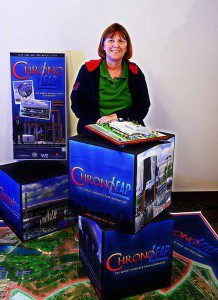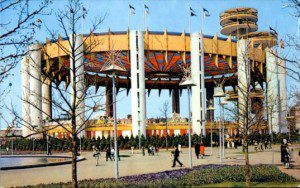Hidden details about the 1964/65 World’s Fair in New York are being brought to the surface by a UCF history professor whose first memory of the event came after most of it had been torn down.

Lori Walters, who also serves as a researcher at UCF’s Institute for Simulation & Training (IST), remembers being captivated when, as a small child growing up on Long Island, they would pass the New York Pavilion site in the car. As her mother described the scope of the Fair and the visions of the future it presented, Walters was hooked.
Now, Walters’ research interests focus on largely on the 1950’s and 1960’s and the tremendous technological changes that occurred in that era. She is passionate about teaching young people about science and technology and has found a way to use her bent for history to do it.
To help celebrate the 50th anniversary of the New York World’s Fair, Walters is preparing to debut a digital recreation of the event that she has directed for the past four years. In June she will visit the World’s Fair site with 50-60 middle school students from neighboring Nassau County to instruct them in a project that will use a toaster-sized FARO LiDAR scanner to record one of the few remaining structures – the New York State Pavilion.
And, she has joined the ranks of a growing and, thanks to online media, increasingly public group of scholars, archeologists and mystery enthusiasts looking to study what they believe are the remains of one of the Fair’s lesser-known attraction, the Underground House.
The Underground Home was designed at a time during the Cold War when many Americans were worried about the potential for nuclear attack. Jay Swayze, a Texas builder, began experimenting with the idea of building functioning, livable homes located protectively under three to four feet of dirt.
One of his clients got Swayze in the door at the Fair and financed the construction of the Underground House pavilion. Visitors entered the pavilion for an informational session before descending into the elaborate ten-room structure featuring such amenities as “dial a view” which let occupants choose murals they would see through faux windows. The home also allowed customizable air settings which were fed through a pipe in the roof and eliminated most dust and irritants.
Walters and other scholars and enthusiasts believe the dwelling could still be buried at Flushing Meadows-Corona Park in Queens, which was developed on top of the former World’s Fair site.

After a recent visit to the site, Walters has been featured in media including the websites Narratively – one of TIME’s “50 Best Websites of 2013” – and Inhabitat New York City, promoting her vision of using the possible existence of the Underground House as a modern-day learning tool.
“My interest in the Underground Home stems from its potential to introduce middle school children to urban archeology,” Walters said in the Inhabitat article.
Her plan is not to extract the house but to explore it using one of the tools IST is renowned for building – a small robotic device that could explore and offer viewing through an endoscopic camera.
Walters believes the structure was simply covered up after the upper-level pavilion was torn down along with most of the other exhibits after the Fair closed in the fall of 1965.
Walters can be contacted via her World’s Fair website at http://srealserver.eecs.ucf.edu/chronoleap/contact-us/.


